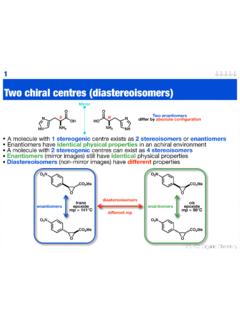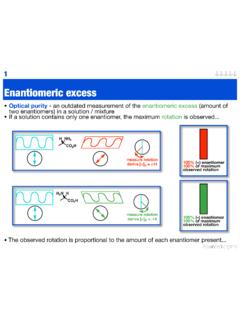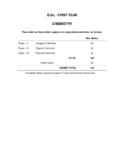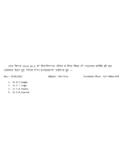Transcription of Syllabus - AICTE-GPAT
1 Page 1 of 54 Syllabus GPAT - 2018 ALL INDIA COUNCIL FOR TECHNICAL EDUCATION Nelson Mandela Marg, Vadsant Kunj, New Delhi-110 070 Page 2 of 54 physical CHEMISTRY 1. Composition & physical states of matter Intermolecular forces & their impact on the state of the matter. Various physical properties of matter, dipole moment, dielectric constant, Van Der Waal's equation & critical phenomenon, liquefaction of gases, aerosols. 2. Colligative properties The liquid state, vapor pressure, ideal & real solutions. Raoult's law, elevation of boiling point, depression of freezing point, osmotic pressure, determination of molecular weight based on colligative properties .
2 3. Thermodynamics First, second & third law of thermodynamics. Thermochemical laws, isothermic & adiabatic processes, reversible processes, work of expansion, heat content, enthalpy, heat capacity. Gibb's & Helmholtz equation & chemical potential. 4. Refractive index Refractive index, specific refractivity, molar refractivity, refractometers. 5. Solutions Solubility, factors affecting solubility, solubility curves. Types of solutions, effect of co-solvency, pH & other factors on solubility. Solubility of gases in liquids, liquids in liquids, & solids in liquids, critical solution temperature, law of partitioning & its applications. Solute-solvent interactions.
3 Expression of the concentration of pharmaceutical solutions & calculations. Molarity, molality, mole fraction & percentage expressions. 6. Electrochemistry properties of electrolyte solutions, electrolysis. Faraday's law of electrolysis, electron transport, electrical cell, single electrode potential, concentration cells, half-cells & half-cell potential, types of half cells, sign convention, Nernst equation, salt bridge, electromotive series, standard potential, SHE. Measuring the relative voltage of half cells, Calculation of standard potential. Reference & indicator electrodes. Standard oxidation-reduction potential. Page 3 of 54 7. Ionic equilibrium Theory of conductivity, equivalent conductance, mobility of ions, specific conductance.
4 8. Kinetics Order of reactions, derivation & internal form of rate laws, molarities of reaction, derivation of rate constants. Page 4 of 54 physical PHARMACY 1. Matter, properties of matter States of matter, change in the state of matter, latent heat and vapor pressure, sublimation-critical point, eutectic mixtures, gases, aerosols- inhalers, relative humidity, liquid complexes, liquid crystals, glasses state, solid crystalline and amorphous polymorphism. 2. Micromeritics and powder rheology Particle size and distribution, average particle size number and weight distribution, particle number, methods of determining particle size and volume, optical microscopy, sieving, sedimentation, determining surface areas, permeability, adsorption, derived properties of powders, porosity, packing arrangement densities, bulkiness and flow properties .
5 3. Surface and interfacial phenomenon Liquid interface, surface and interfacial tensions, surface free energy, measurement of surface and interfacial tension, spreading coefficient, adsorption and liquid interfaces, surface active agents, HLB classification, solubilization, detergency, absorption at solid interfaces, solid gas and solid-liquid interfaces, complex films, electrical properties of interfaces. 4. Viscosity and rheology Newtonian systems, law of flow, kinematics viscosity, effect of temperature, non- Newtonian systems, pseudoplastics, dilatant, plastic, thixotropy in formulations, determination of viscosity and thixotropy by capillary, falling ball, rotational viscometer, application of theology in pharmacy 5.
6 Dispersion systems a. Colloidal dispersions: Definition, types, properties of colloids, protective colloids, application of colloids in pharmacy. b. Suspensions and emulsions: Interfacial properties of suspended particles settling in suspension, theory of sedimentation, effect of Brownian movement, sedimentation of flocculated particles, sedimentation parameters, wetting of particles, significance of electrical properties in dispersions, controlled flocculation, flocculation in structured vehicles, rheological considerations, emulsions: types, theories, physical stability. 6. Complexation Classification of complexes, methods of preparations and analysis, applications.
7 Page 5 of 54 7. Buffer Buffer equations and buffer capacity in general. Buffers in pharmaceutical systems, preparations and stability, buffered isotonic solutions. Measurements of tonicity calculations and methods of adjusting isotonicity. 8. Solubility a. Miscibility-influence of foreign substances three component systems; dielectric constant and solubility, solubility of solids in liquids ideal and non-ideal solutions solvation and association in solutions solubility of salts in water solubility of slightly soluble and weak electrolyte calculating solubility of weak electrolytes as influenced by pH, influence of solvents on the solubility of drugs combined effect of pH and solvents, distribution of solutes between immiscible solvents, effect of ionic dissociation and molecular association on partition, extraction, preservatives action of weak acids in emulsions, drug action and distribution coefficient.
8 B. Concepts of dissolution and diffusion. Page 6 of 54 ORGANIC CHEMISTRY 1. General principles A brief review of classification & sources of organic compounds, sp3, sp2, sp hybridization, sigma & pi- bonds, bond lengths, bond angles & bond energies along with their significance in reactions should be carried out. An overview of bond polarization, hydrogen bonds, inductive effects, resonance, and hyperconjugation be taken. Concept of homolytic & heterolytic bond fission, acidity & basicity with different theories should be covered briefly. Ease of formation & order of stabilities of electron deficient & electron rich species along with the reasons for the same should be covered.
9 Relationships between energy content, stability, reactivity & their importance in chemical reactions should be covered. Calculations for determining empirical & molecular formula should be covered. 2. Different classes of compounds The following classes of compounds should be taught in detail with respect to their IUPAC / systematic nomenclature, industrial [wherever applicable] & laboratory methods of preparations, physical properties & chemical reactions with emphasis on reaction mechanisms [arrow based] & stereochemistry [wherever applicable]. Alkanes [including cyclic compounds] Alkenes [including cyclic compounds] Alkynes [only open-chain compounds] Aliphatic hydroxyl compounds Alkyl halides Aldehydes & Ketones Carboxylic acids All functional derivatives of carboxylic acids.
10 3. Protection & deprotection of groups Introduction to protection & deprotection of functional groups. Two examples each for amino, hydroxyl, & carbonyl groups. The significance of these in syntheses should be explained. 4. Aromaticity & chemistry of aromatic compounds Concept of aromaticity, Huckel's rule & its use in determining the aromatic/non-aromatic Page 7 of 54 character of a compound. A brief coverage of structure of benzene. Detailed coverage of electrophilic & nucleophilic aromatic substitution reactions. Reactivity & orientation in these reactions. Reactivity & orientation in mono- & disubstituted benzenes. Benzyne mechanism. 5. Different aromatic classes of compounds The following classes of compounds with respect to their IUPAC / systematic nomenclature, industrial [wherever applicable] & laboratory methods of preparations, physical properties & chemical reactions with emphasis on reaction mechanisms [arrow based] & stereochemistry [wherever applicable].






